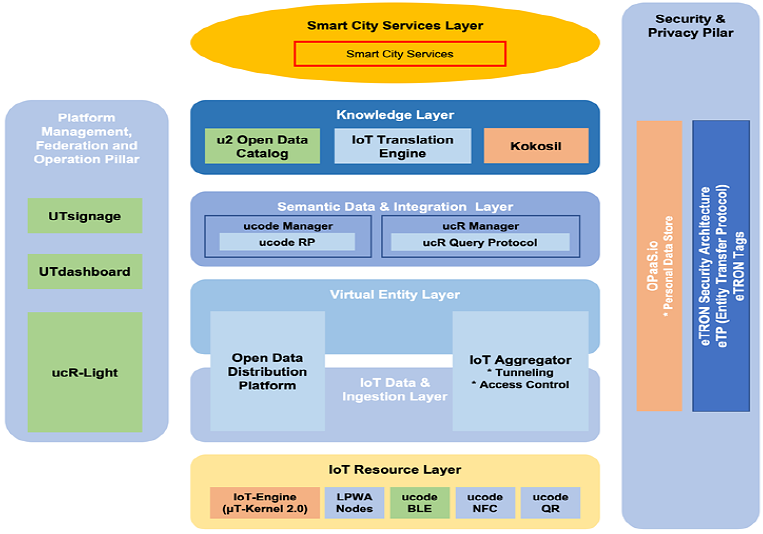The IoT controls our environments. That includes environments of each individual residence and individual office, as one of many areas that the IoT controls. The collection of those environments is the city environment.
Current city environment has following issues in many areas;
- Issues caused by lack of resources due to population concentration
- Advanced transportation service
- solution for traffic jam
- car or bicycle sharing
- Environmental issues
- water pollution
- air pollution
- regional initiatives for energy saving
- Disaster prevention
- flood control for torrential rain
- how to guide people to evacuate in case of flood disaster, earthquake, hurricane, etc.
- Allocation of safe environment
- security enhancement including counter-terrorism, etc.
For the issues as above, approach of smart city is to find solution and clues, making effective use of big data analysis, open data from the government and private sectors.
YRP UNL has conducted research and experimentation, applying outcome of research activities of the IoT and various open data such as the one offered by Association for Open Data of Public Transportation (ODPT).
We have been developing smart city experiments in various parts of Japan, including serving as the Japanese representative for CPaaS.io, an EU-Japan joint collaborative project (two years and six months).
Case Study 1: City Platform as a Service, integrated open (CPaaS.io)
CPaaS.io was a project to develop a software platform that can be used to solve urban issues that cities in the EU and Japan face today by mean of the IoT. The project started in July 2016 officially as an EU-Japan collaborative project.
Sponsors / Members
Project funding was done by EU Horizon 2020 project on the EU side, and was done by National Institute of Information and Communications Technology (NICT) on the Japan side. The project spanned 30 months from July 2016.
E-Government Institute of Bern University of Applied Sciences was the EU coordinator and Japanese coordinator was YRP Ubiquitous Networking Laboratory.
| Japan | EU |
| Coordinator: YRP Ubiquitous Networking Laboratory | Coordinator: Bern University of Applied Science [Switzerland] |
| Microsoft Japan., Ltd. | AGT Group (R&D) GmbH [Germany] |
| ACCESS CO., LTD. | NEC Laboratories Europe GmbH [Germany] (NEC Europe Ltd. [U.K.] at the start of the project) |
| Ubiquitous Computing Technology Corporation | Odin Solutions S.L. [Spain] |
| Koshizuka Laboratory, the University of Tokyo (Sakamura-Koshizuka Lab at the start of the project) | The Things Industries [Holland] |
| University of Surry [U.K.] |
Design Philosophy
EU partners used FIWARE for the reference implementation of IoT application architecture while Japanese partners used IoT-Aggregator (u2 architecture). FIWARE has been used widely as an infrastructure of the IoT applications and has become an important pillar along with the Japanese IoT-Aggregator in the CPaaS.io project.
The project on the Japan side has created a CPaaS.io architecture for smart city innovation that links cloud servers with sensors and other embedded devices.

Case Study 2: Prototype Experiments / Use Cases
Prototype experiments have taken place in cities to learn the requirements for solving urban problems and to validate the effectiveness of the architecture.
In Japan, tourism support in Sapporo, emergency medical care in Yokosuka and public transportation in Tokyo are three targets. “Open Data Challenge for Public Transportation in Tokyo” contest held by the ODPT uses the technology based on CPaaS.io design philosophy and framework (vocabulary, data structure, API, etc.)
In Europe, sewage water control after heavy rain in Amsterdam, and event management of “Color Run,” parking space management in Murcia (Spain) have been tried.
The last year of the project, 2018, saw experiments that connected the EU and Japanese instantiations of CPaaS.io. There the recently highlighted private data management issues (exemplified by EU’s GDPR) posed practical problems.
Effectiveness of OPaaS.io’s dashboard was confirmed there.
Case Study 3: City Stakeholders Meetings
In order to learn the requirements from city governments and to promote the project, City Stakeholders meetings have been held twice in Japan (at 2017 TRON Symposium and 2018 TRON Symposium) and once in the EU. A panel session was held at 2018 TRON Symposium. At the 2018 TRON Symposium, the representatives from Amsterdam, Murcia, Sapporo, Tokyo, Yokosuka, and Zurich presented their views and exchanged opinions. At the symposium, Tokyo had a special session dedicated to it to discuss its pressing issues related to Tokyo Olympic and Paralympic Games in 2020.


The support from these city governments is essential for the deployment of the project’s result. TRON Forum members have worked with the ODPT, Sapporo Open Data Association, etc. and these past activities were very useful for CPaaS.io.
Project Summary and Future
The 30-month project ended at the end of December 2018. UNL hopes to incorporate the technologies and findings developed into future smart city projects. Interested city stakeholders are encouraged to contact cpaas@bfh.ch.
